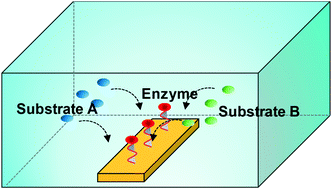Our official English website, www.x-mol.net, welcomes your feedback! (Note: you will need to create a separate account there.)
Diffusion–reaction kinetics of microfluidic amperometric biosensors†
Lab on a Chip ( IF 6.1 ) Pub Date : 2018-09-12 00:00:00 , DOI: 10.1039/c8lc00794b Hui Li 1, 2, 3 , Yi Lu 1, 2, 3 , Pak Kin Wong 1, 2, 2, 3, 4
Lab on a Chip ( IF 6.1 ) Pub Date : 2018-09-12 00:00:00 , DOI: 10.1039/c8lc00794b Hui Li 1, 2, 3 , Yi Lu 1, 2, 3 , Pak Kin Wong 1, 2, 2, 3, 4
Affiliation

|
Amperometric biosensors are widely applied for rapid biomarker detection in physiological and environmental samples. The dynamics and linearity of the current signal, however, are only partially understood. This study investigates the diffusion–reaction kinetics of amperometric biosensing using a self-assembled monolayer (SAM) based biosensor for bacterial 16S rRNA. A numerical model is developed to optimize the chamber dimensions and elucidate the concentration dependences of the biosensor. The results revealed that depletion of substrates associated with the chamber dimension can limit the current signal in a target concentration dependent manner. This study provides practical guidelines in the design and interpretation of microfluidic amperometric biosensors for biochemical applications.
中文翻译:

微流安培生物传感器的扩散反应动力学†
安培生物传感器广泛应用于生理和环境样品中的快速生物标志物检测。但是,电流信号的动态性和线性度仅得到部分了解。这项研究调查了使用基于自组装单层(SAM)的细菌16S rRNA生物传感器的安培生物传感的扩散反应动力学。建立了数值模型以优化腔室尺寸并阐明生物传感器的浓度依赖性。结果表明,与腔室尺寸相关的基板耗竭可以以目标浓度依赖的方式限制电流信号。这项研究为生化应用的微流安培生物传感器的设计和解释提供了实用指南。
更新日期:2018-09-12
中文翻译:

微流安培生物传感器的扩散反应动力学†
安培生物传感器广泛应用于生理和环境样品中的快速生物标志物检测。但是,电流信号的动态性和线性度仅得到部分了解。这项研究调查了使用基于自组装单层(SAM)的细菌16S rRNA生物传感器的安培生物传感的扩散反应动力学。建立了数值模型以优化腔室尺寸并阐明生物传感器的浓度依赖性。结果表明,与腔室尺寸相关的基板耗竭可以以目标浓度依赖的方式限制电流信号。这项研究为生化应用的微流安培生物传感器的设计和解释提供了实用指南。



























 京公网安备 11010802027423号
京公网安备 11010802027423号